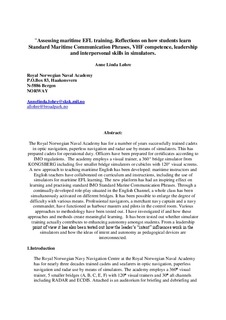Assessing maritime EFL training. Reflections on how students learn Standard Maritime Communication Phrases, VHF competence, leadership and interpersonal skills in simulators.
Others
Permanent lenke
http://hdl.handle.net/11250/2390502Utgivelsesdato
2009Metadata
Vis full innførselSamlinger
- Artikler [235]
Sammendrag
The Royal Norwegian Naval Academy has for a number of years successfully trained cadets in optic navigation, paperless navigation and radar use by means of simulators. This has prepared cadets for operational duty. Officers have been prepared for certificates according to IMO regulations. The academy employs a visual trainer, a 360° bridge simulator from KONGSBERG including five smaller bridge simulators or cubicles with 120° visual screens. A new approach to teaching maritime English has been developed: maritime instructors and English teachers have collaborated on curriculum and instructions, including the use of simulators for maritime EFL learning. The new platform has had an inspiring effect on learning and practising standard IMO Standard Marine Communication Phrases. Through a continually developed role-play situated in the English Channel, a whole class has been simultaneously activated on different bridges. It has been possible to enlarge the degree of difficulty with various means. Professional navigators, a merchant navy captain and a navy commander, have functioned as harbour masters and pilots in the control room. Various approaches to methodology have been tested out. I have investigated if and how these approaches and methods create meaningful learning. It has been tested out whether simulator training actually contributes to enhancing autonomy amongst students. From a leadership point of view it has also been tested out how the leader’s “intent” influences work in the simulators and how the ideas of intent and autonomy as pedagogical devices are interconnected.
